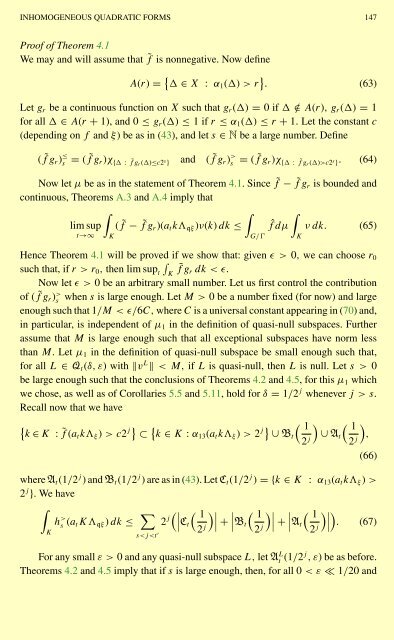NEAR OPTIMAL BOUNDS IN FREIMAN'S THEOREM
NEAR OPTIMAL BOUNDS IN FREIMAN'S THEOREM
NEAR OPTIMAL BOUNDS IN FREIMAN'S THEOREM
Create successful ePaper yourself
Turn your PDF publications into a flip-book with our unique Google optimized e-Paper software.
<strong>IN</strong>HOMOGENEOUS QUADRATIC FORMS 147<br />
Proof of Theorem 4.1<br />
We may and will assume that ˜f is nonnegative. Now define<br />
A(r) = ∈ X : α1() >r . (63)<br />
Let gr be a continuous function on X such that gr() = 0 if /∈ A(r), gr() = 1<br />
for all ∈ A(r + 1), and0 ≤ gr() ≤ 1 if r ≤ α1() ≤ r + 1. Let the constant c<br />
(depending on f and ξ) beasin(43), and let s ∈ N be a large number. Define<br />
( fgr) ˜ ≤<br />
s = ( fgr)χ ˜<br />
{ : fgr ˜ ()≤c2s } and ( fgr) ˜ ><br />
s = ( fgr)χ ˜<br />
{ : fgr ˜ ()>c2s }. (64)<br />
Now let µ be as in the statement of Theorem 4.1.Sincef˜−fgr ˜ is bounded and<br />
continuous, Theorems A.3 and A.4 imply that<br />
<br />
<br />
lim sup ( f˜ − fgr)(atkqξ)ν(k) ˜<br />
dk ≤ fdµ ˆ νdk. (65)<br />
t→∞ K<br />
G/ Ɣ K<br />
Hence Theorem 4.1 will be proved if we show that: given ɛ>0, we can choose r0<br />
<br />
such that, if r>r0, then lim supt K ˜ fgr dk < ɛ.<br />
Now let ɛ>0 be an arbitrary small number. Let us first control the contribution<br />
of ( fgr) ˜ > s when s is large enough. Let M>0 beanumberfixed(fornow)andlarge<br />
enough such that 1/M < ɛ/6C,where C is a universal constant appearing in (70) and,<br />
in particular, is independent of µ1 in the definition of quasi-null subspaces. Further<br />
assume that M is large enough such that all exceptional subspaces have norm less<br />
than M. Let µ1 in the definition of quasi-null subspace be small enough such that,<br />
for all L ∈ Qt(δ, ε) with vL 0<br />
be large enough such that the conclusions of Theorems 4.2 and 4.5, for this µ1 which<br />
we chose, as well as of Corollaries 5.5 and 5.11, hold for δ = 1/2j whenever j>s.<br />
Recall now that we have<br />
<br />
k ∈ K : ˜f (atkξ) >c2 j ⊂ k ∈ K : α13(atkξ) > 2 j <br />
1<br />
∪ Bt<br />
2j <br />
1<br />
∪ At<br />
2j <br />
,<br />
where At(1/2 j ) and Bt(1/2 j ) are as in (43). Let Ct(1/2 j ) ={k ∈ K : α13(atkξ) ><br />
2 j }.Wehave<br />
<br />
K<br />
h ><br />
s (atKqξ) dk ≤ <br />
s

















